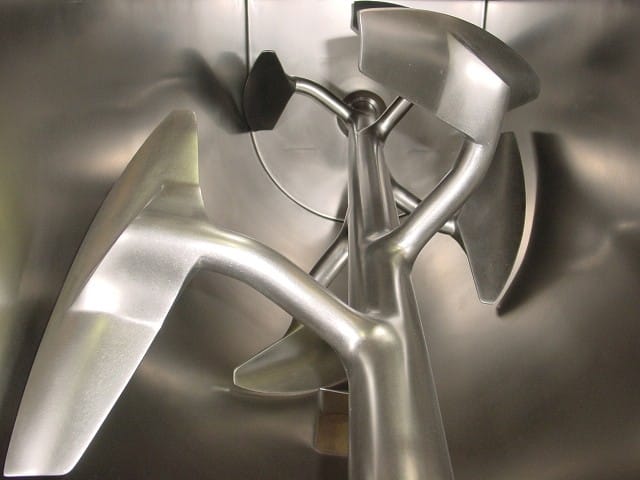Paddle Mixers
Whereas ribbon blenders create opposing streams in a vessel, paddle mixers create a tumbling effect by lifting the mix and letting gravity do the rest. This method is the gentler way of mixing product, though it may be slower per cubic foot of mixer volume. They’re available with nearly any configuration necessary for your product.

Benefits
For the right product, paddle mixers’ benefits will be as follows:
- Uniform Mixing: Paddle mixers’ tumbling/folding principle is inherently better for some mixes.
- Versatile: Paddle mixers are capable of mixing a wide range of dry powders, granules, and pastes.
- Gentle: Paddle mixers rely as much on product-to-product contact as product-to-agitator for mixing, which reduces friction.
Options
All mixers we source can be configured and customized to fit the application it best fits. These options include but are not limited to:
- Vacuum: Configurations are available where a near-0 vacuum can be pulled
- Microwave: Microwave mixers can hold temperatures within 0.5 degrees F
- Load Cells: Mixers can be put on load cells to weigh and control inputs that are not self-weighed or metered with another solution.
- Surge Hopper Integration: We can integrate hoppers to allow use of batch mixers in continuous processes
- Custom Lids: Various inputs or lids of custom shapes, lift-assist, or safety features can be added
- Bolt-On Paddles: For abrasive products that can eat through paddles, they can be made replaceable. The trade-off is cleanability, as bolts and nuts create crevices.
- Bolt-On-Arms: For extremely harsh products that erode even the arms, those too can be made bolt-on. The trade-off is cleanability and strength.
Drawbacks
- Limited Speed: Paddle mixers will be slower than other methods, requiring a larger mixer to attain the same speed.
- Potentially Limited Efficiency: Depending on the product, you also need to make sure there aren’t spots the paddles are missing and allowing product to dwell in.
When to Use:
- Mixing Fragile Materials: Paddle mixers are ideal for mixing fragile materials that are easily damaged or degraded by the shear or heat of other mixing methods.
- Mixing Non-Abrasive Materials: Paddle mixers are ideal for mixing non-abrasive materials that do not require high-shear mixing.
- Dry And Semi-Dry Materials: Powders and granules like flour, sugar, fertilizer, and plastics are all products commonly mixed by paddle mixers.
When Not to Use:
- Mixing Abrasive Materials: Normal paddle mixers are not suitable for mixing certain abrasive materials, as the paddles will wear down over time and be expensive to replace. For some products, where metal particles in the product are not a concern, this can be solved with bolt-on arms or paddles as mentioned above so they can be easily and cheaply removed.
- Liquid and highly viscous materials: Material that is too runny to be lifted by the paddles, or too thick to be tumbled will not be a good fit for paddle mixers.
To learn about the options available for you appliaction or how we can optimize your system, give us a call or fill out the form below.